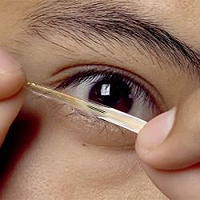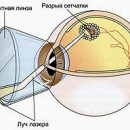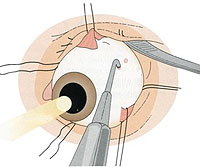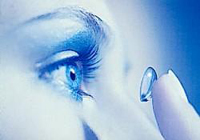Began to get tired eyes? After working at the computer worse you see? It's time to measure eye pressure. Even better to do it every year.
Content
Few do this examination regularly. And in vain: Even if the vision is only pleased, measure intraocular pressure, or, in scientific, ophthalmus, it is necessary every year, especially after 40 years. It is fast, absolutely not hurt, and most importantly, can get rid of the heap of problems in the future.
There are several fundamentally different methods for measuring ophthalmotonus. They have different accuracy. Not everyone is equally available. And the main question of the patient — How comfortable each of them?
Fingers on apples
The easiest way to measure intraocular pressure — palpator, manually. And although it is not possible to obtain accurate data in MM mercury post, doctors often use them to indicate eye status assessment.
The patient is asked to look as low as possible and emeses with two index fingers alternately pressed on the eyeball, trying to determine how elastic sheath eye in the sclera area. The result is estimated by a special scale from +2 to -2 points. This method is good for the assessment of postoperative and pathological states of the eye, but is not suitable for thin diagnostic and screening research.
My feelings. I was waiting for a spark from the eye to fall out. No — everything was very gentle and carefully.
Easy and accuracy
 The most common device today — Maclakova Tonometer, Metal Cylindrik with extensions at the ends, like a small dumbbell. On the ends — Round plates with a diameter of 1 cm made of milk glass, plastic or porcelain. Before measuring, they are lubricated with special brown glycerin paint.
The most common device today — Maclakova Tonometer, Metal Cylindrik with extensions at the ends, like a small dumbbell. On the ends — Round plates with a diameter of 1 cm made of milk glass, plastic or porcelain. Before measuring, they are lubricated with special brown glycerin paint.
The patient is placed, instant anesthetic eye drops and a tonometer to the cornea is applied for 1-2 seconds. Under his weight, the cornea is flattened, in the contact zone, the paint is washed off, and an unpainted circle of a certain diameter appears on the painted plate. It is measured by a special ruler by calculating pressure indicators by a specific formula.
The procedure takes 2-3 minutes for each eye. The method is very simple, but it is quite accurate.
In the high rank clinics use the Goldman Tonometer. It uses the principle of Maclakova's opposite principle: measure the power of the pressure of a special prism on the cornea to the diameter of the flattening platform was equal to 3.06 mm. After anesthesia in the eye, the dye of the fluorescene is buried, the patient is seated to a special microscope with illuminator. The optical prism of the device closer to the cornea of the eye and watch the process in the eyepiece. Data on intraocular pressure is read from a special scale. Research lasts about 5 minutes. The accuracy of the data obtained in this way is very high.
My feelings. Warnings that after instillation anesthetic will feel discomfort, — Pleasant lies. Even a slight burning albucid is much more unpleasant. Paint disappears from the eye instantly and not noticeable. Just to hold back the first instinctive blink is impossible.
Poppong
Electronic tonometers — The most accurate and informative. In them, pressure indicators are immediately designated on an electronic scale. In the eye, anesthetic is burned, a transparent funnel is placed between the centuries, which does not allow blinking. In the hole of the funnel on the cornea install a light metal cylinder. He slightly jumps around the cornea like a ball.
Electronic tonometers work in two modes. One — Normal, Tonometry, Other — Tonography. When holding the last sensor is on the cornea to 4 minutes. This study makes it possible to estimate the movement of fluid movement in the eye, which is important for the diagnosis of certain diseases.
My feelings. Anesthesia — Great business: it would be impossible to wear an eye funnel without her. Lying 4 minutes, staring at one point, of course, uncomfortable, but «Racing» The cylinder is not felt. The only flaw — It is unpleasant to realize that the tip is not sterilized. It is possible to console the fact that the tear will quickly wake up all unnecessary from the eye with anesthetic.
Wind in the eyes
Last achievement — Electronic contactless tonsometers, or pneumotonometers. They affect the cornea of the air jet; The whole process takes no more than a minute, anesthesia is not required. The patient is seated for a special table, asked to fix a look at the target in the lens of the device and produce a special press. The sensations of a short blow about the eyes of the finest jet of air are practically not felt. The device immediately prints the results.
Such tonometers are no longer uncommon even in state clinics. The only problem — The accuracy of measurements suffers when approaching the upper and lower boundary of the norm, as well as if you have a thin cornea.
My feelings. You ever a grandmother spoiled in the eye during barley? Grandma is much worse. The system of installing the head and aiming into the eye somewhat resembles the fitting of the body under the X-ray. Then light cotton, blow, involuntary blink and — Get the result.
For home for family
Modern electronic tonometers are portable — For example, in the form of a fountain pen. They work very quickly, but only when contacting the eye; Anesthetizing drops are mandatory.
There are also portable tonometers measuring ophthalmotonus after a century, that is, without touching the cornea of the eyeball. However, the accuracy of all these measurements is low.









